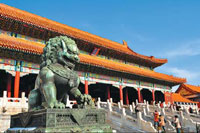
 'Taken 2' grabs movie box office crown
'Taken 2' grabs movie box office crown
 Rihanna's 'Diamonds' tops UK pop chart
Rihanna's 'Diamonds' tops UK pop chart
 Fans get look at vintage Rolling Stones
Fans get look at vintage Rolling Stones
 Celebrities attend Power of Women event
Celebrities attend Power of Women event
 Ang Lee breaks 'every rule' to make unlikely new Life of Pi film
Ang Lee breaks 'every rule' to make unlikely new Life of Pi film
 Rihanna almost thrown out of nightclub
Rihanna almost thrown out of nightclub
 'Dark Knight' wins weekend box office
'Dark Knight' wins weekend box office
 'Total Recall' stars gather in Beverly Hills
'Total Recall' stars gather in Beverly Hills
Forbidden City comes alive
Updated: 2013-01-25 13:49
(China Daily)
|
||||||||
The Palace Museum, the China Arts and Entertainment Group and Beijing Gehua Cultural Development Group recently signed an agreement to co-produce a large-scale cultural show named The Forbidden City.
 |
The production tells how the Ming Emperor Zhu Di (1360-1424) established his capital at Beijing and constructed the Forbidden City, and narrates the epic construction of the royal complex. The whole show contains several chapters organized in chronological sequence, such as Establishing the Capital, Migration and Blue Print. During the performance, a miniature Forbidden City will rise up, and the audience can even walk through its central axis.
Several advanced art demonstration venues including a 270-degree stage space, central water stage and circle main stage will be used to make the presentation true to life.
There will also be a Forbidden City Art Center that is specifically constructed for the show. About 120,000 to 150,000 square meters in size, the art center will have one floor above the ground and three floors below the ground.
Aside from a modern theater, the art center will have exhibition halls and cultural tourism-related facilities.
In the collaboration, the Palace Museum will focus on the show's storyline and cultural aspects. The China Arts and Entertainment Group will be responsible for the show's performance management and daily operation, and Beijing Gehua Cultural Development Group will focus on the construction of the art center.
"The show will present the cultural significance of the Forbidden City in the form of a stage performance, which combines both history and present day. It will become a new cultural landmark of Beijing," comments Palace Museum director Shan Jixiang.
China Arts and Entertainment Group vice-president Han Ziyong agrees, adding that "the show will be a perfect marriage of cultural value, entertainment and city cultural space".
zhangzixuan@chinadaily.com.cn
Most Viewed
Editor's Picks

|

|

|

|

|

|
Today's Top News
Boston bombing suspect reported cornered on boat
7.0-magnitude quake hits Sichuan
Cross-talk artist helps to spread the word
'Green' awareness levels drop in Beijing
Palace Museum spruces up
First couple on Time's list of most influential
H7N9 flu transmission studied
Trading channels 'need to broaden'
US Weekly

|

|







